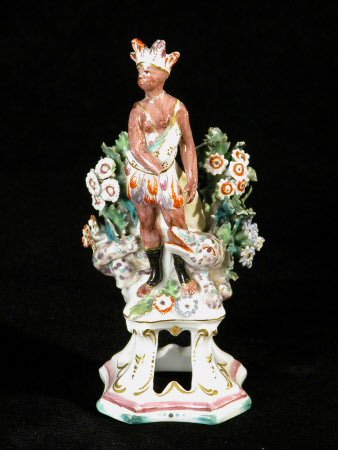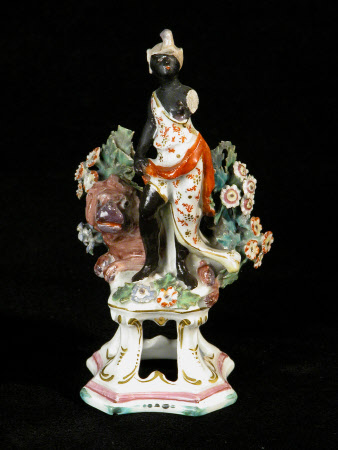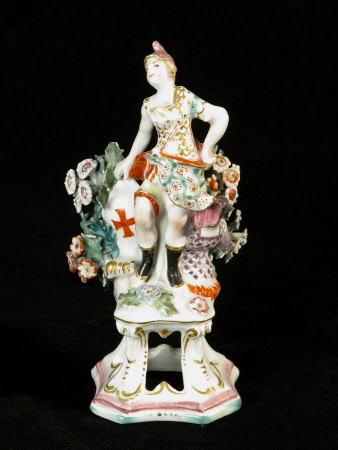The Four Continents
Bow Porcelain Factory (fl.c. 1748-1774)
Category
Ceramics
Date
c. 1765
Materials
soft paste porcelain
Measurements
135 x 48 mm; 60 mm (Length)
Place of origin
Stratford-le-Bow
Order this imageCollection
Saltram, Devon
NT 870875
Summary
Set of figures of the Four Continents made at the Bow factory, c.1765. Soft paste porcelain, moulded and assembled on high bases. Decorated in polychrome enamels with gilding. Each is marked on the reverse of the figure, just above the base with red anchor and dagger marks for Bow 1750-1776. The Saltram Collection (1967): No 244T, p.48
Full description
Figure sets such as these were influenced by the production of sculpted figures and animals from the prestigious Meissen factory in Germany. Originally intended as themed centrepieces for the dessert table, they also came to be displayed as ornaments above chimneypieces or in vitrines. Sets of four seasons, elements and continents made popular subjects. This set was produced in England at the Bow porcelain factory c.1765. The figures are allegorical depictions of the Four Continents based on European notions of the known world. Each is personified as a female figure bearing attributes or objects associated with the continent. These kinds of depictions were standardised in the extremely popular publication Iconologia, an emblem book by Cesare Ripa (c.1560-1622) published in Rome in 1603. These depictions promoted a Euro-centric view of the world whereby Europe was shown with symbols of enlightenment and superiority, and where Africa, Asia and America were depicted as ‘exotic’ and with commodities that were to be exploited. As such they became symbols of Empire and wealth of the nations they represented. These kinds of depictions continued to be popular and recognisable in the 18th century but promoted the continued stereotyping and marginalisation of peoples from these continents. Europe is personified as a woman wearing robes and a military helmet, holding a shield with a suit of armour by her side to emphasise military dominance. America is personified as a woman painted brown and wearing a feathered headdress and skirt standing in front of an alligator. This depiction is a reference to the Indigenous peoples of the ‘new’ continent of America and its potential for Europeans to exploit their fertile lands. Africa is personified as a woman wearing robes and is painted black. She is shown with an elephant headdress with a lion at her feet - a reference to the fierce animals and the perceived exotic dangers of the continent. Asia is personified as a woman wearing robes with a turban at her feet. She holds a perfume censer which showcases the continent’s rich production of spices and incense. Listed in the 1894 inventory as being displayed in Lady Morley's sitting room. Terminology Note: These types of porcelain figures (particularly Africa and Asia) have historically, in sales and collection inventories, been referred to as ‘Blackamoor’ figures. The term ‘moor’ derives from the Greek work ‘mauros’ meaning ‘black’ or ‘very dark’ and, in the medieval and early modern periods, was an ill-defined stereotype applied to Muslims of the Islamic Iberian Peninsula and North Africa. Usage developed to conflate Muslims of any ethnicity with black Sub-Saharan Africans. People of colour were considered to reflect a luxury within European households, where many were enslaved or employed, although often unpaid, as domestic staff.
Provenance
At Saltram by 1951 and accepted by HM Treasury in lieu of full payment of Death Duty from the Executors of Edmund Robert Parker (1877-1951), 4th Earl of Morley
Makers and roles
Bow Porcelain Factory (fl.c. 1748-1774), manufacturer
References
The Saltram Collection (1967):, No. 244T, p.48



